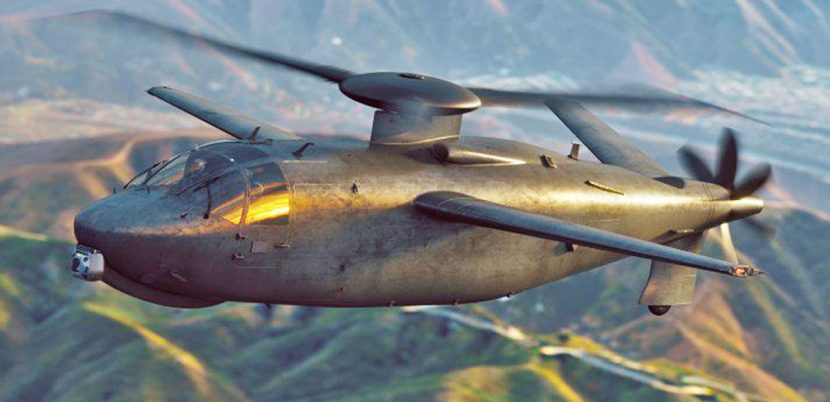
Karem Aircraft is a recent and little-known company in
the aerospace industry. But your story deserves attention. Founded in 2004 by
Abraham Karem, creator of the MQ-1 Predator, and based in California, the
company is one of five competitors in the US Army’s Future Attack
Reconnaissance Aircraft (FARA) program to choose a new attack and scout
helicopter.
Abraham Karem has revealed a different competitor to
the FARA program. Called AR40, the advanced helicopter brings together some
interesting concepts such as rigid rotor where blade movement is independent,
with a pivoted pusher rotor. According to Karem, the AR40 uses the tail rotor
as anti-torque at slower speeds while rotating to the longitudinal position on
cruise flights. The main rotor torque in this case is nullified by a vertical
stabilizer. The AR40 has a main rotor of just 11 meters in diameter and tilting
wings with 12.2 meter wingspan. Powered by a GE Aviation T901 engine, the
aircraft has two side-by-side seats plus a four-occupant rear cabin. Karem has
partnered with Northrop Grumman and Raytheon, companies with the most
experience in providing aircraft and systems to the US government, but believes
its proposal is the most efficient and economical – capable of exceeding the
180kt speed required by technical requirements.
Karem Proposes AR40 Active-Rotor Compound Helicopter
Aviation Week & Space Technology
Graham Warwick
Mon, 2019-10-14 09:00
Karem Aircraft is offering a high-speed compound helicopter
with an actively controlled main rotor for the U.S. Army’s Future Attack
Reconnaissance Aircraft (FARA) program. The company has teamed with Northrop
Grumman and Raytheon to propose its AR40 design.
The AR40 is an active-rotor, winged, compound helicopter.
“The hallmark feature is it can fly fast,” says Thomas Berger, Karem’s FARA
program manager. “We go past the threshold requirement by about 20% and do it
without any additional auxiliary propulsion on a single [General Electric] T901
engine.”
The FARA requirements set a threshold maximum speed of 180
kt., so this implies the AR40 can reach about 215 kt. The reference to
auxiliary propulsion points to Bell’s FARA contender, the single-main-rotor 360
Invictus, which uses a supplemental power unit to achieve its 185-kt. maximum
speed.
Founded by Predator designer Abe Karem, the company is
better known for development of the Optimum Speed Tilt Rotor (OSTR). But the
Army’s requirement that FARA fit within a 40-ft. box so it can fly between
buildings in urban conflicts rules out a tiltrotor design.
The AR40 has a single main rotor, a wing, and unique
swiveling tail rotor. This provides anti-torque control at low speed, but
swivels aft to provide propulsion for higher forward speed. “This is the best
design we know to attack the requirement. It has low drag and low vibration at
high speed,” Berger says.
The model designation AR40 stands for “40-ft. active rotor.”
In a conventional rotor, a swashplate and pitch links mechanically transmit
cyclic and collective blade-pitch commands to the rotor head. In Karem’s active
rotor, the blades are individually controlled by electric actuators in the hub.
This allows blade pitch to be precisely controlled to maximize performance and
minimize drag and vibration at high speed, Berger says. Additionally, power for
the full-authority individual blade control actuators is generated within the
hub, he says, eliminating the need for slip rings to transfer electrical power
to the rotating rotor.
The main rotor has three stiff, lightweight blades and a
rigid, hingeless hub. The lack of a swashplate and pitch links results in a
slim pylon between fuselage and rotor, reducing drag. To achieve high speed,
“we reduce drag significantly and unload the rotor to the wing,” Berger says.
“The swiveling tail rotor means we do not have the edgewise drag of a tail
rotor. We store all the ordnance inside, stow the gun and fair the targeting
turret.”
Despite the emphasis on reducing drag, the AR40 has
side-by-side seating. This improves crew coordination and provides additional
room behind the cockpit for mission equipment or a cabin for personnel. “It’s
space for free,” he says.
While no active rotor has yet progressed beyond the R&D
stage, Karem is developing the component technology under the Army’s Joint
Multi Role technology demonstration (JMR TD). Under this program, the company
will ground-test a 36-ft. variable-speed rotor for its OSTR design for the
Army’s planned Future Long-Range Assault (FLRAA) replacement for the Sikorsky
UH-60 Black Hawk.
The OSTR uses the same active control, lightweight blade and
rigid hub technology as the AR40. The JMR TD rotor “is under component test,
with the integrated test next year,” Berger says. “It will directly help reduce
risk for [the AR40’s] individual blade control, rigid hub, blades, etc.”
Karem has worked with the Army’s science and technology
community for many years, first on Joint Heavy Lift and later on JMR TD, but is
still a relative unknown and so has teamed with heavyweight partners: Northrop
Grumman for airframe production and support and Raytheon for the mission
system.
“Karem is the driving pioneer of the rotor and drive system.
Northrop Grumman brings full OEM production and support capability,” he says.
Northrop company Scaled Composites is also involved, and will likely build the
prototype if the AR40 wins one of the two competitive prototype contracts to be
awarded in March.
Northrop Grumman Mission Systems will provide the avionics
and cockpit integration. Raytheon will perform mission-system integration using
its experience with modular open-architecture systems. “We have teamed with big
OEMs who have the ability to provide managed risk,” Berger says.
In addition to competing for FARA, Karem plans to respond to
the Army’s request for proposals for the two-year competitive demonstration and
risk-reduction phase of the FLRAA program, proposing its TR36 OSTR. “We are
participating in FLRAA,” says Bruce Tenney, director of military VTOL business
development. Karem is working under a one-year extension to its JMR TD
contract, which includes refining its FLRAA concept.